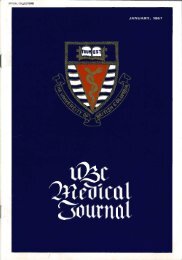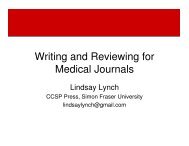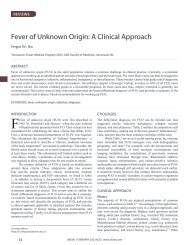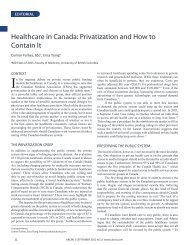Download full PDF - UBC Medical Journal
Download full PDF - UBC Medical Journal
Download full PDF - UBC Medical Journal
Create successful ePaper yourself
Turn your PDF publications into a flip-book with our unique Google optimized e-Paper software.
YEAR 3<br />
(monosomy 5, monosomy 7, del(5q), abnormal 3q, and complex<br />
karyotypes). The poor disease outcome of patients with complex<br />
karyotypes have been described in many studies, but a recent<br />
study Breems et al. (2008) addressed the contribution of the<br />
different components of complex karyotypes and reported a poor<br />
prognosis in patients with any type of autosomal monosomy,<br />
and an even poorer prognosis of karyotypes with at least two<br />
autosomal monosomies or a single monosomy plus one or more<br />
structural cytogenetic abnormalities.<br />
Methods: The initial cytogenetic reports of patients with AML<br />
between January 1, 1983 and June 30, 2005 were reviewed. The<br />
study determined the median and mean survival of patients based<br />
on the prognostic groups defined above. The same parameters<br />
were evaluated again for two different age groups (patients < 60<br />
years old at diagnosis vs. patients >60 years old at diagnosis).<br />
Overall survival was calculated at 4 years for all patients and then<br />
for the different age groups. Median and mean survival was the<br />
calculated on patients with one or more monosomies.<br />
Results: When dividing AML into the previously identified<br />
favourable, intermediate and adverse prognostic groups, the<br />
results are in keeping with previous reports: patients with “good<br />
prognosis” karyotypes have higher mean and median survivals<br />
and patients in the “poor prognosis” group demonstrate lower<br />
mean and median survivals. In this group, the lowest survival was<br />
observed for patients with monosomy 5.<br />
Does Pre-biopsy Contrast Enema<br />
Delay the Diagnosis of Long Segment<br />
Hirschsprung’s Disease<br />
Justin Chen 1 , Douglas H. Jamieson 2 , Erik Skarsgard 1<br />
1<br />
Department of Surgery, BC Children’s Hospital, University of<br />
British Columbia<br />
2<br />
Department of Radiology, BC Children’s Hospital, University of<br />
British Columbia<br />
Background/Purpose: The diagnosis of long segment<br />
Hirschsprung’s disease (LSHD) is frequently delayed. Our<br />
purpose was to: 1) evaluate utility of contrast enema (CE) by<br />
comparing LSHD patients managed with/without pre-biopsy CE,<br />
2) summarize CE findings in patients with LSHD patients, and 3)<br />
evaluate the impact of initial CE reports on outcome.<br />
Methods: All LSHD cases (transition zone {TZ} proximal to<br />
splenic flexure) treated between 1984 and 2009 were stratified<br />
by whether a pre-biopsy CE was done (Group 1), or not (Group<br />
2). Group comparisons included elapsed days from admission<br />
to diagnostic rectal biopsy, first operation, and initial length of<br />
hospital stay (LOS). CEs were reviewed by a single pediatric<br />
radiologist, and the original reports were categorized as “helpful”,<br />
“non-specific”, or “misleading”.<br />
Results: 29 patients (16 -Group 1; 13 -Group 2) were identified.<br />
Group 1 patients experienced a significant delay in time to<br />
biopsy (p=0.047), first operation (p=0.005), and showed a trend<br />
towards prolonged LOS. CE review revealed TZ in 7/16 (44%);<br />
and of these, 6 (86%) underestimated actual aganglionic segment<br />
length. 6/16 (38%) original CE reports were “misleading” and<br />
those patients showed a trend towards a delay in rectal biopsy<br />
and experienced significantly longer lengths of stay. There was<br />
a significantly higher proportion of patients with small bowel<br />
aganglionosis in the group with misleading reports.<br />
Conclusions: Pre-biopsy CE offers little to the diagnosis of LSHD<br />
and likely contributes to diagnosis/treatment delays. Even if a TZ<br />
is recognized in biopsy proven HD, the predicted aganglionic<br />
segment length should not guide operative planning.<br />
A Web-based tool for family-initiated<br />
adverse event reporting: an enduser<br />
investigation of usability and<br />
reliability<br />
Jeremy Daniels 1 , Ashlee King 1 , Kate Hunc 1 , D. Douglas<br />
Cochrane 2 , Annemarie Taylor 3 , Susan Heathcote 3 ,<br />
Joanne Lim 1 , J. Mark Ansermino 1<br />
1<br />
Pediatric Anesthesia, University of British Columbia<br />
2<br />
Neurosurgery Department, University of British Columbia<br />
3<br />
Patient Safety & Learning System, Provincial Health Services<br />
Authority<br />
Objectives: To assess the usability and reliability of a web-based<br />
adverse event reporting tool designed for families of children<br />
admitted to hospital.<br />
Introduction: Usability is a strong predictor of adoption of a new<br />
technology, and reliability is essential when making decisions<br />
based on information. Family reports of adverse events have been<br />
shown to be reliable and able to identify events not reported by<br />
health care providers. Through an iterative design process using<br />
previous publications, expert opinion, and family feedback, a<br />
web-based tool to allow families to report adverse events was<br />
developed.<br />
Methods: Following Institutional Review board approval, 25<br />
parents of pediatric patients consented to participate. Sample<br />
size was determined by qualitative needs and not statistical<br />
significance. Fifteen families used the web based tool to report<br />
on their child’s hospital stay and completed a validated usability<br />
questionnaire. Ten parents used the adverse event reporting tool to<br />
report 6 fictional adverse event scenarios, from which reliability<br />
was assessed.<br />
Results: Average usability was 2.1 on a 7-point scale (1 =<br />
maximum, 7 = minimum score). High usability scores (2.5) for on-screen<br />
messages and likeability of using the tool. Examples of elements<br />
that were given low and high usability scores will be provided.<br />
Parents showed acceptable (80.2%), but imperfect reliability in<br />
classifying scenarios.<br />
Conclusion: Good usability scores predict that parents will<br />
use the tool to report adverse events that occur in hospital, and<br />
acceptable reliability implies that the system will be acceptable<br />
to safety analysts.<br />
<strong>UBC</strong>MJ | APRIL 2010 1(2) | www.ubcmj.com 15










